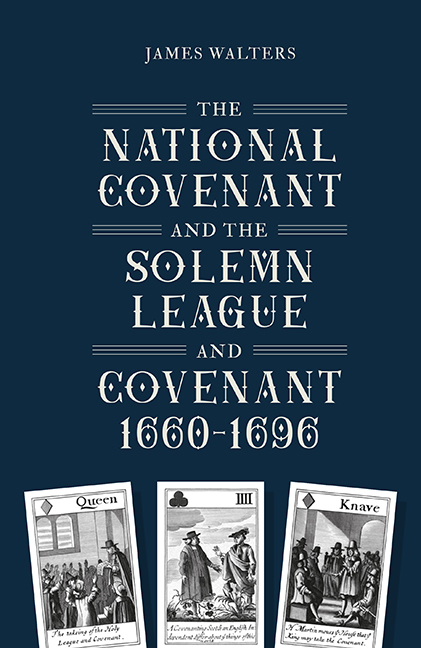Book contents
- Frontmatter
- Contentst
- List of Illustrations
- Acknowledgements
- Introduction
- 1 The 1638 National Covenant and the 1643 Solemn League and Covenant
- 2 1660: What Was to Be Restored?
- 3 The Act of Uniformity and the ‘Great Ejection’
- 4 Crisis and Toleration in the 1660s
- 5 Exclusion and Association in the Late Restoration Period
- 6 The Revolution of 1688 and the Association of 1696
- Conclusion
- Bibliography
- Index
- STUDIES IN EARLY MODERN CULTURAL, POLITICAL AND SOCIAL HISTORY
1 - The 1638 National Covenant and the 1643 Solemn League and Covenant
Published online by Cambridge University Press: 26 May 2022
- Frontmatter
- Contentst
- List of Illustrations
- Acknowledgements
- Introduction
- 1 The 1638 National Covenant and the 1643 Solemn League and Covenant
- 2 1660: What Was to Be Restored?
- 3 The Act of Uniformity and the ‘Great Ejection’
- 4 Crisis and Toleration in the 1660s
- 5 Exclusion and Association in the Late Restoration Period
- 6 The Revolution of 1688 and the Association of 1696
- Conclusion
- Bibliography
- Index
- STUDIES IN EARLY MODERN CULTURAL, POLITICAL AND SOCIAL HISTORY
Summary
This chapter will explore the background and nature of the National Covenant (1638) and the Solemn League and Covenant (1643) in order to provide the necessary context for addressing the role that the Covenants, particularly the Solemn League and Covenant, and their signatories, played during the Restoration period. Firstly, a brief word on precisely what the two Covenants were. The National Covenant represented the culmination of Scottish displeasure regarding the efforts of Charles I and his supporters, such as Archbishop William Laud, to bring the Scottish Kirk more in line with the Church of England. Though controversies stemming from the divisions between English and Scottish Protestantism had flared up at several points since the Union of Crowns, Laud's time as archbishop had increased tensions, which erupted into rioting following the imposition of a new Scottish Prayer Book in July 1637.
In response to these proposed changes, and the outcry they caused, Archibald Johnson, a lawyer, and Alexander Henderson, a minister from Fife, drafted the National Covenant. The National Covenant had a three-part structure which began by restating the 1581 ‘Negative Confession’, which was an oath agreed to by James VI, to reject ‘that Roman Antichrist’ and ‘his worldly monarchie and wicked hierarchy’. This was followed by a list of acts of parliament and other precedents such as Charles's coronation in Scotland, which were presented as defining the legitimate church and its proper relationship to royal authority. Finally, the National Covenant contained the new bond by which its signatories pledged to defend these precedents and what they saw as the legitimate constitution of church and state. As this National Covenant was distributed around the country, Covenanters organised parliamentary and clerical representatives into ‘Tables’ which ‘evolved into a provisional government’.
However, even as the National Covenant was being circulated and signed, the precise nature of the Kirk which its signatories pledged to defend was still not entirely clear. The extent to which the ‘wicked hierarchy’ proscribed by the 1581 Confession referred to any form of episcopacy had been subject to dispute since the 1580s. Subsequent developments such as the ‘Black Acts’ of 1584, and the 1618 ‘Articles of Perth’, had sparked heated debate around whether there was a legitimate role for bishops in the Kirk, and whether such a role was compatible with the Confession of 1581.
- Type
- Chapter
- Information
- Publisher: Boydell & BrewerPrint publication year: 2022

